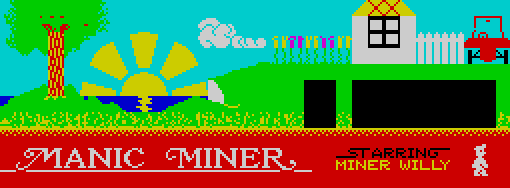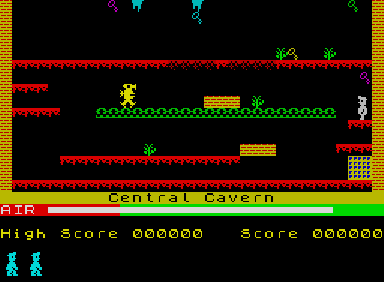
In the 1980’s, miners were more notable for picket lines, pitched battles with the police and their part in an ideological struggle with Thatcher’s Britain that threatened at times to boil over into an actual gloves-off class war. There was little time for jumping around on conveyor belts in abandoned uranium mines to Johan Strauss’ Blue Danube waltz. Unless, that is, you were the lucky owner of a ZX Spectrum, and were playing the Software Project’s ground breaking platform game, Manic Miner.
It was, in fact, the royalty-free Danube Waltz (and also the equally gratis Hall of the Mountain King by Grieg, which also featured) that made Manic Miner a bona fide legend: they comprised the very first in-game soundtrack. It was generally felt that a computer would collapse in on itself like a black hole under this kind of pressure, and Matthew Smith, who wrote the game, achieved a considerable feat by doing so. Smith discovered the fairly obvious trick of switching processor time betwixt game and music, which accounts for Manic Miner’s occasionally slightly jerky soundtrack. Smith’s breakthrough is all the more remarkable when it is remembered that he was also trying to do his A levels at the time.
 Manic Miner is very colourful, very cheerful and, somehow, very friendly. The hero, who is actually called Miner Willy – the ‘Manic’ nickname presumably given to him by friends and co workers – rushes around a series of underground caves, collecting flashing keys. When he has collected all the keys in a particular cave, a portal appears, through which he can scuttle to the next level. And so on. With the Spectrum’s central processor already at melting point, there was never going to much spare memory available for complex plot chicanery. Fortunately, the split-second timing required to guide the gallant undergroundsman as he bounced about all over the place made Manic Miner extremely addictive. Not only that, but the central character, despite being dressed more like a lumberjack than a miner, in open necked red shirt and jeans, was highly likeable. He just wasn’t the sort of chap you wanted to fall victim to any of the perils he faced: wayward mining robots, poisonous pansies, spiders, slime, stepping off a platform and hurtling to certain death, or running out of oxygen and asphyxiating.
Manic Miner is very colourful, very cheerful and, somehow, very friendly. The hero, who is actually called Miner Willy – the ‘Manic’ nickname presumably given to him by friends and co workers – rushes around a series of underground caves, collecting flashing keys. When he has collected all the keys in a particular cave, a portal appears, through which he can scuttle to the next level. And so on. With the Spectrum’s central processor already at melting point, there was never going to much spare memory available for complex plot chicanery. Fortunately, the split-second timing required to guide the gallant undergroundsman as he bounced about all over the place made Manic Miner extremely addictive. Not only that, but the central character, despite being dressed more like a lumberjack than a miner, in open necked red shirt and jeans, was highly likeable. He just wasn’t the sort of chap you wanted to fall victim to any of the perils he faced: wayward mining robots, poisonous pansies, spiders, slime, stepping off a platform and hurtling to certain death, or running out of oxygen and asphyxiating.
The overall effect of Smith’s humble but brilliant game upon the contemporary gaming industry was immense. It topped the Golden Joystick awards for 1983, in which gamers would vote for their favourite titles by rather touchingly filling out a coupon and posting it. It was also voted at number 25 in the greatest games of all time – although this was the greatest games of all time in 1983, of course. Several other versions of the game appeared some with as many as sixty additional levels – the original only had twenty – and Smith was immediately commissioned to write Jet Set Willy, the game’s official sequel. We can only guess at the further havoc this wreaked upon his academic studies.
In short, Smith, did an awful lot with not very much, a hallmark of all the great early games designers. We shall be following his homework-disrupting career next time, when we examine Jet Set Willy.

3 Comments
Awesome game. Quite playable even today. I have found that the same screens that irked me back in the day do the same now. Thank god for being able to set invisible or infinite lives.
Hey there! This is the second time visiting now and I personally just wanted to say I
truley relish looking through your blog website.
I’ve decided to bookmark it at stumbleupon.com with the title: Get Your Willy Out and your Domain name: http://retrogt.com/blog/get-your-willy-out-its-manic-miner-126.html. I hope this is alright with you, I’m trying to give your wonderful blog a bit more exposure.
Be back soon.
Hello! I’ve been following your web site for a long time now and finally got
the bravery to go ahead and give you a shout out from Porter
Texas! Just wanted to tell you keep up the excellent work!